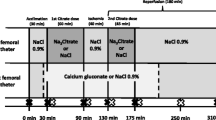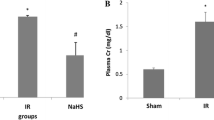Abstract
Renal ischemia injures the renal tubular cell by disrupting the vital cellular metabolic machinery. Further cell damage is caused when the blood flow is restored by oxygen free radicals that are generated from xanthine oxidase. Oxygen radicals cause lipid peroxidation of cell and organelle membranes, disrupting the structural integrity and capacity for cell transport and energy metabolism. In the present study, the possible therapeutic usefulness of the adenosine deaminase inhibitor, 2′-deoxycoformycin (DCF), during renal ischemia and reperfusion injury was investigated. The effects of DCF on renal malondialdehyde (MDA) and ATP levels were studied after 45 min ischemia and 15 min subsequent reperfusion in rat kidneys. MDA levels remained unchanged during ischemia, but increased after the subsequent reperfusion. DCF pretreatment (2.0 mg/kg i.m.) decreased MDA and increased ATP levels during the ischemia-reperfusion period. DCF exerts a dual protective action by facilitating purine salvage for ATP synthesis and inhibiting oxygen radical-induced lipid peroxidation. These results suggest that DCF therapy could be beneficial in the treatment of ischemia-reperfusion renal injuries.
Similar content being viewed by others
References
Paller MS. Acute renal failure: controversies, clinical trials, and future. Semin Nephrol 1998; 18:482.
Hems DA, BrosnaN JT. Effects of ischaemia on content of metabolites in rat liver and kidney in vivo. Biochem J 1970; 120:105.
Paller MS, Hoidal JR, Ferris TF. Oxygen free radicals in ischemic acute renal failure in the rat. J Clin Invest 1984; 74:1156.
Greene EL, Paller MS. Xanthine oxidase produces O2-. in posthypoxic injury of renal epithelial cells. Am J Physiol 1992; 263:F251.
Linas SL, Whittenburg D, Repine JE. Role of xanthine oxidase in ischemia/reperfusion injury. Am J Physiol 1990; 258:F711.
Granger DN, Rutili G, McCord JM. Superoxide radicals in feline intestinal ischemia. Gastroenterology 1981; 81:22.
Cross CE, Halliwell B, Borish ET, et al. Oxygen radicals and human disease (clinical conference). Ann Intern Med 1987; 107:526.
Greene EL, Paller MS. Oxygen free radicals in acute renal failure. Miner Electrolyte Metab 1991; 17:124.
Yavuz O, Turkozkan N, Bilgihan A, Dogulu F, Aykol S. The effect of 2-chloroadenosine on lipid peroxide level during experimental cerebral ischemia-reperfusion in gerbils. Free Radic Biol Med 1997; 22:337.
Turkozkan N, Bilighan A, Cayci B, Dogulu F, Aykol S. The effects of 2-chloroadenosine and deoxycoformycin on the ATP level, Na-K ATPase activity in experimental brain ischemia of gerbil. Neurol Res 1996; 18:345.
Turkozkan N, Aykol S, Bilgihan A, Yavuz O, Cayci B, Dogulu F. The effect of 2-chloroadenosine on the ATP level Na,K ATPase activity in experimental brain ischemia of gerbil. Gen Pharmacol 1996; 27:165.
Phillips E, Newsholme EA. Maximum activities, properties and distribution of 5′ nucleotidase, adenosine kinase and adenosine deaminase in rat and human brain. J Neurochem 1979; 33:553.
Aricioglu A, Aydin S, Turkozkan N, Durmus O. The effect of allopurinol on Na+K+ATPase related lipid peroxidation in ischemic and reperfused rabbit kidney. Gen Pharmacol 1994; 25:341.
Mihara M, Uchiyama M. Determination of malonaldehyde precursor in tissues by thiobarbituric acid test. Anal Biochem 1978; 86:271.
Lamprecht WI, Trautsch E. Adenosine 5-triphosphate determination with hexokinase and glucose-6-P-dehydrogenase. In: Bergmeyer HU, ed. Methods of enzymatic analysis. London: Academic Press; 1971:543–551.
Goldberg DM. Serum adenosine deaminase in differential diagnosis of jaundice. Br Med J 1965; 1:353.
Paller MS, Hebbel RP. Ethane production as a measure of lipid peroxidation after renal ischemia. Am J Physiol 1986; 251:F839.
Pfaller W. Structure function correlation on rat kidney. Quantitative correlation of structure and function in the normal and injured rat kidney. Adv Anat Embryol Cell Biol 1982; 70:1.
Karasawa A, Kubo K. Protection by benidipine hydrochloride (KW-3049), a calcium antagonist, of ischemic kidney in rats via inhibitions of Ca-overload, ATP-decline and lipid peroxidation. Jpn J Pharmacol 1990; 52:553.
Green CJ, Healing G, Lunec J, Fuller BJ, Simpkin S. Evidence of free-radical-induced damage in rabbit kidneys after simple hypothermic preservation and autotransplantation. Transplantation 1986; 41:161.
Agarwal RP, Spector T, Parks RE Jr. Tight-binding inhibitors. IV. Inhibition of adenosine deaminases by various inhibitors. Biochem Pharmacol 1977; 26:359.
Nosaka K, Takahashi T, Nishi T, et al. An adenosine deaminase inhibitor prevents puromycin aminonucleoside nephrotoxicity. Free Radic Biol Med 1997; 22:597.
Stromski ME, Waarde A van, Avison MJ, et al. Metabolic and functional consequences of inhibiting adenosine deaminase during renal ischemia in rats. J Clin Invest 1988; 82:1694.
Bolling SF, Bies LE, Bove EL, Gallagher KP. Augmenting intracellular adenosine improves myocardial recovery. J Thorac Cardiovasc Surg 1990; 99:469.
Sandhu GS, Burrier AC, Janero DR. Adenosine deaminase inhibitors attenuate ischemic injury and preserve energy balance in isolated guinea pig heart. Am J Physiol 1993; 265:H1249.
Lin Y, Phillis JW. Deoxycoformycin and oxypurinol: protection against focal ischemic brain injury in the rat. Brain Res 1992; 571:272.
Jordan JE, Zhao ZQ, Sato H, Taft S, Vinten Johansen J. Adenosine A2 receptor activation attenuates reperfusion injury by inhibiting neutrophil accumulation, superoxide generation and coronary endothelial adherence. J Pharmacol Exp Ther 1997; 280:301.
Wu PH, Phillis JW, Thierry DL. Adenosine receptor agonists inhibit K+-evoked Ca2+ uptake by rat brain cortical synaptosomes. J Neurochem 1982; 39:700.
Sumpio BE, Hull MJ, Baue AE, Chaudry IH. Comparison of effects of ATP-MgCl2 and adenosine-MgCl2 on renal function following ischemia. Am J Physiol 1987; 252:R388.
Phillis JW, O’Regan MH. Deoxycoformycin antagonizes ischemia-induced neuronal degeneration. Brain Res Bull 1989; 22:537.
Author information
Authors and Affiliations
Rights and permissions
About this article
Cite this article
Bor, M.V., Durmuş, O., Bilgihan, A. et al. The beneficial effect of 2′-deoxycoformycin in renal ischemia-reperfusion is mediated both by preservation of tissue ATP and inhibition of lipid peroxidation. Int J Clin Lab Res 29, 75–79 (1999). https://doi.org/10.1007/s005990050067
Received:
Accepted:
Issue Date:
DOI: https://doi.org/10.1007/s005990050067




